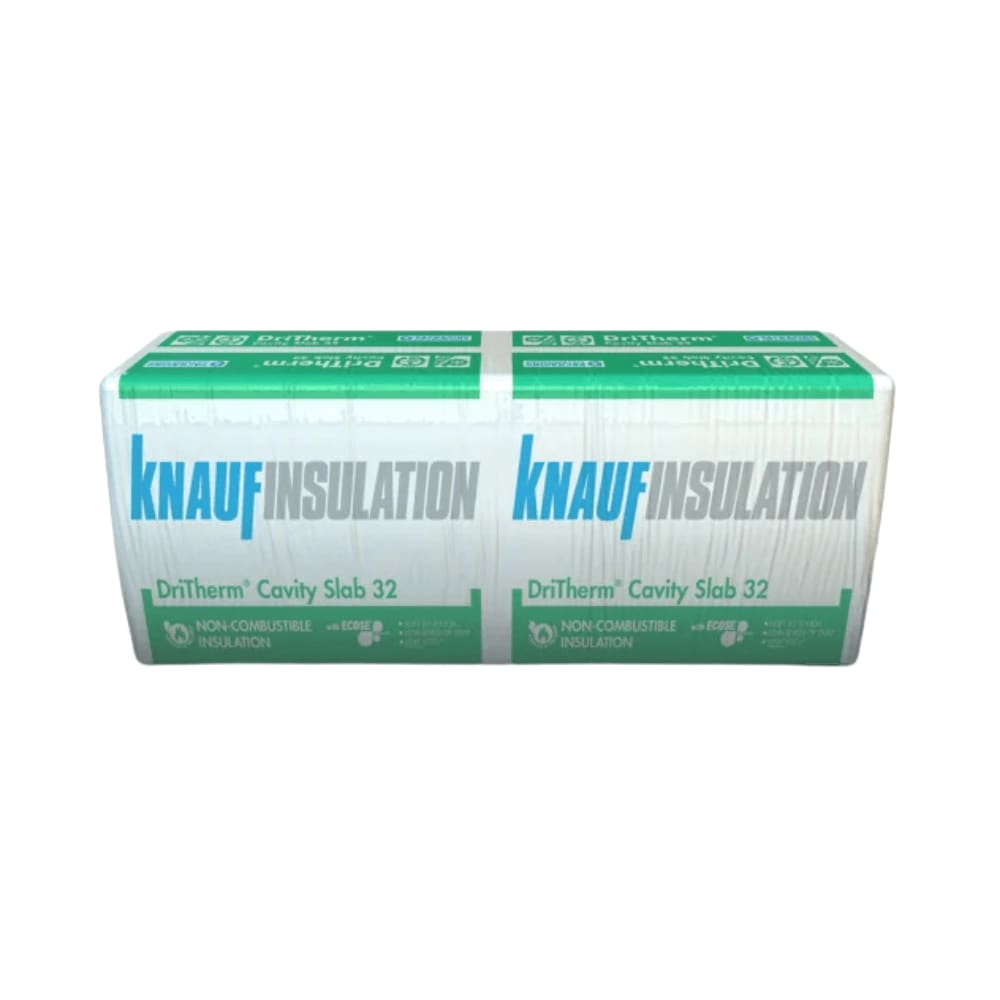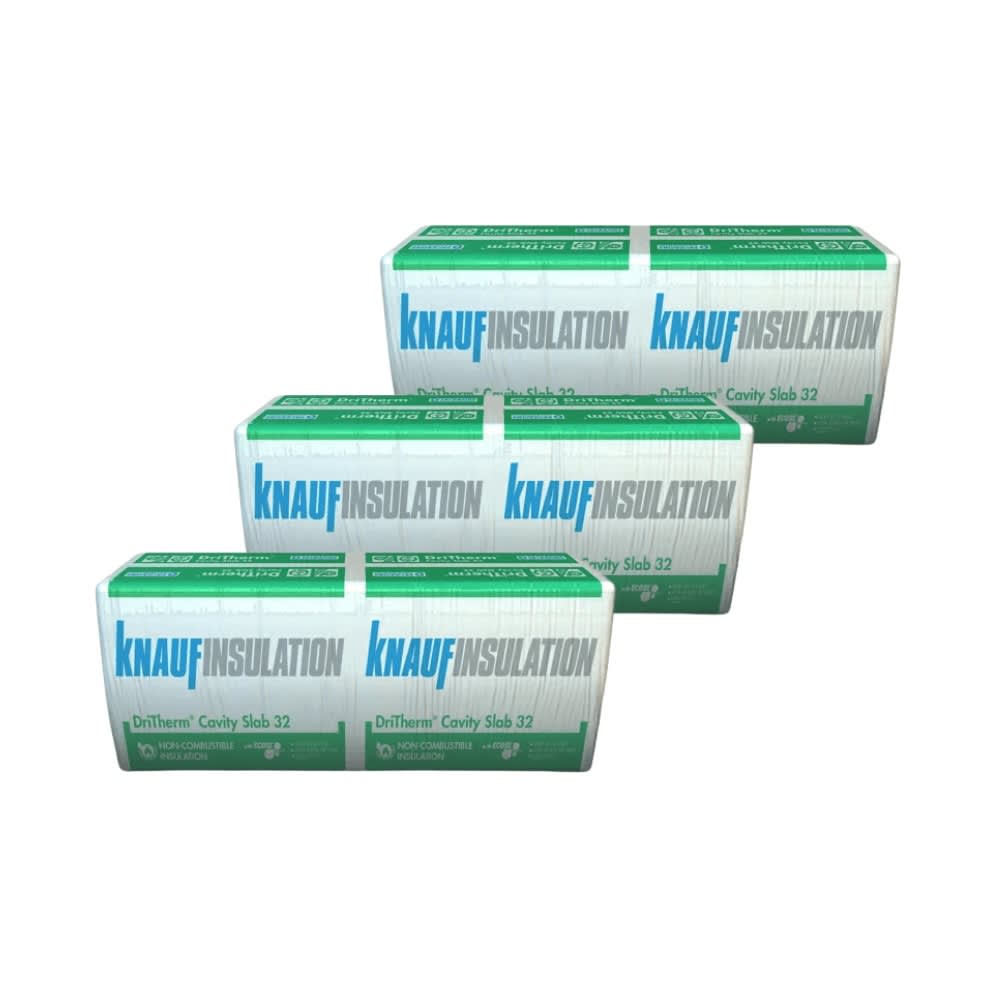Knauf DriTherm 32 Cavity Slabs
(6 Products)Knauf DriTherm 32 slabs are glass-mineral wool boards made to fill masonry cavities edge to edge. Their semi-rigid form allows each piece to slide between the wall ties and press tightly against the surrounding brick leaves. With the cavity packed tight, there’s nowhere for air gaps to form, so warmth stays inside and heat loss is kept to a minimum.
With a thermal conductivity of 0.032 W/mK, the slabs provide strong insulation with relatively little thickness. They’re also rated Euroclass A1 for fire safety, meaning the material is non-combustible and suitable for use in buildings where fire resistance is a priority.
What are Knauf DriTherm 32 Cavity Slabs?
Knauf DriTherm 32 Cavity Slabs are semi-rigid boards of glass mineral wool designed for full-fill masonry cavities. They are manufactured with Knauf’s ECOSE binder, which is free from added formaldehyde and helps lower the product’s embodied carbon.
These slabs are sized to line up with standard wall tie spacing. This allows them to sit in the cavity without needing extra fixings.
They hold their shape and stay in place, creating a close fit that helps limit unwanted air movement. A water-repellent treatment also helps the slabs stay efficient even if the cavity becomes damp.
The “32” in the name corresponds to the slab’s thermal conductivity of 0.032 W/mK. Because lower conductivities mean better resistance to heat flow, you can often reach the required U-value without adding much thickness to the wall build-up.
Full-Fill Application
Knauf DriTherm 32 slabs occupy the cavity between masonry leaves. By filling the space from edge to edge, they help block air movement and maintain consistent thermal performance throughout the wall.
Benefits
- Strong Thermal Performance: Helps to keep internal spaces warmer by reducing heat loss through the wall. Their full-fill design also helps limit cold patches and lowers the chance of condensation forming inside.
- Non-Combustible: Made from glass mineral wool, the material is rated Euroclass A1 – meaning it won’t burn or contribute to fire spread within the cavity.
- Moisture Resistanc: A water-repellent additive is infused into each slab during manufacturing. This helps prevent moisture from seeping in if the outer wall becomes damp, so the insulation keeps working as intended.
- Full Cavity Fill: The slabs are made to press gently against the inner and outer masonry leaves, sealing the cavity without gaps and helping reduce unwanted airflow.
- Long-Term Stability: Their thermal performance remains consistent throughout the life of the building.
- Sustainably Made: Produced using a high proportion of recycled glass, DriTherm slabs support lower environmental impact and help reduce demand for raw materials.
Installation Advice
- Keep the Cavity Clean: Before fitting, make sure the cavity is free from mortar snots and any loose material that might affect the fit.
- Wall Tie Placement: Follow current building regulations when installing wall ties. Clean ties help ensure the slabs sit tightly and don’t snag on mortar or debris.
- Friction Fit: These slabs are made to grip the cavity by slight compression. A snug fit is essential for performance, so measure and cut carefully.
- No Gaps: Boards should be fitted in a continuous layer. Joints must be tight, and vertical seams should be staggered between rows for better coverage.
- Work Around Openings: Pay close attention when fitting slabs around window and door frames. Insulation should meet the frame cleanly to avoid cold spots.
- Stay Dry on Site: Although moisture-resistant, the slabs should be stored undercover and protected from rain before use.
- Details Matter: Areas like wall bases, eaves, and openings need particular care to maintain the integrity of the insulation layer and stop air leaks or water ingress.
For best results, always follow the latest product-specific guidance from Knauf Insulation.
Frequently Asked Knauf DriTherm 32 Questions
Are Knauf DriTherm 32 Cavity Slabs Waterproof Or Just Water Repellent?
Knauf DriTherm 32 Cavity Slabs are manufactured to be water repellent, not fully waterproof. This is a crucial distinction, especially for cavity wall applications.
The glass mineral wool fibres are treated with a special additive during the manufacturing process that causes them to shed liquid water rather than absorb it.
This ensures that any incidental moisture or wind-driven rain that might penetrate the outer masonry leaf does not soak into the insulation, preserving its thermal performance and preventing damp from tracking across the cavity to the inner leaf.
While it resists liquid water, it remains vapour permeable, allowing water vapour to pass through. This permeability is vital for allowing the cavity to breathe and for moisture to escape, preventing interstitial condensation build-up within the wall structure.
Does Knauf DriTherm 32 Slump Or Settle In The Cavity Over Time?
No, Knauf DriTherm 32 Cavity Slabs are specifically designed as semi-rigid slabs to maintain their position and integrity within the cavity over time, preventing slumping or settling.
The manufacturing process results in a robust, dimensionally stable product that, when properly friction-fitted between wall ties and securely abutted, will stay in place for the lifetime of the building.
This stability helps avoid thermal bridges and cold spots caused by gaps at the top or bottom of the cavity, or by insulation compression, ensuring consistent performance throughout the building's life.
Are There Any Special Considerations For Storing Knauf DriTherm 32 Slabs On Site?
Yes, correct storage of Knauf DriTherm 32 Cavity Slabs on site is essential to maintain their performance characteristics and prevent damage before installation.
Although the product is water repellent, prolonged or improper exposure to moisture can still compromise its integrity and thermal properties.
Key storage considerations include:
- Keep Dry: Always store the slabs in a dry location. While they are water-repellent, they should not be left exposed to rain or standing water for extended periods.
- Protect from Ground Contact: Store packs off the ground on pallets or bearers to prevent moisture wicking up from the soil.
- Under Cover: If stored outdoors, ensure packs are completely covered with a waterproof tarpaulin or sheeting that is securely tied down to prevent water ingress and wind damage. Ensure there is adequate air circulation underneath the cover to prevent condensation.
- Protect from UV: Prolonged exposure to direct sunlight (UV radiation) can degrade the packaging and, over time, potentially affect the outer fibres of the insulation.
- Prevent Physical Damage: Store packs in an area where they are unlikely to be punctured, compressed, or otherwise physically damaged by site traffic or other materials. Damage can compromise the slab's integrity and its ability to friction-fit correctly.





